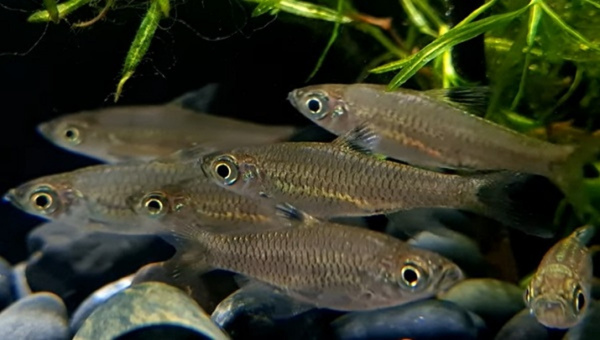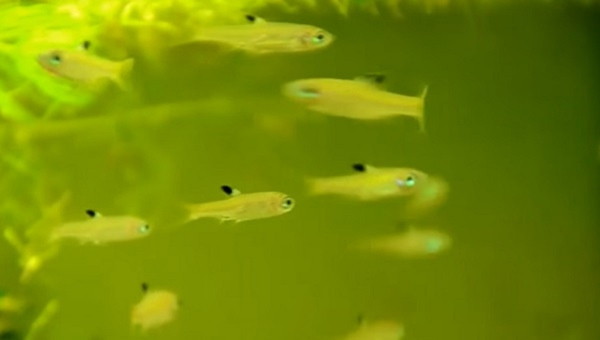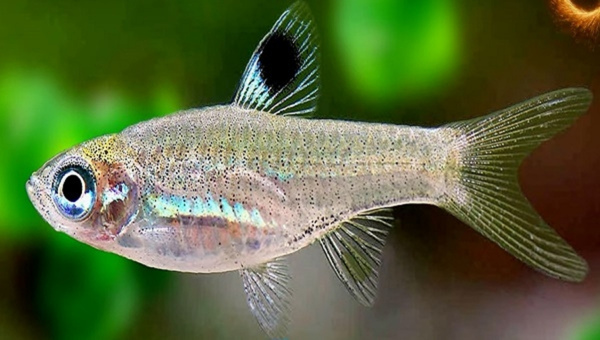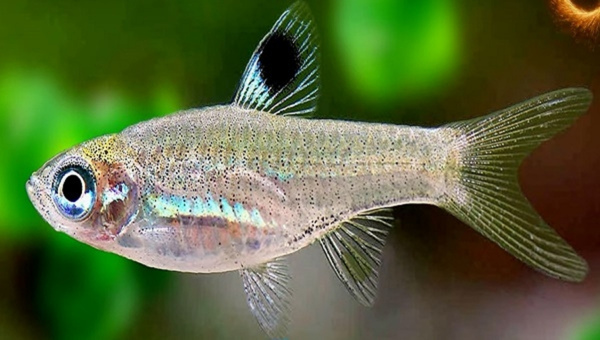The Emerald Eye Rasbora is a peaceful, schooling fish native to Southeast Asia. It is a hardy fish that is relatively easy to care for, making it a good choice for beginner aquarium hobbyists.
It is from the family Cyprinidae, and its scientific name is Brevibora dorsiocellata. The Emerald Eye Rasbora is also known as the Kubota’s rasbora, blue-eye rasbora, and green-eyed rasbora.
While they are popular aquarium fish, Emerald Eye Rasboras face challenges in the wild. The palm oil industry and other problems are threatening their natural habitat.
Emerald Eye Rasboras live in blackwater streams and rivers, and they prefer a lot of vegetation, as their natural habitat is scattered with leaves and twigs.
Table of Contents
- Species Summary
- Emerald Eye Rasbora Care Guide
- Emerald Eye Rasbora Tank Size
- Emerald Eye Rasbora Tank Conditions
- Filtration
- Lighting
- Decoration
- Substrate
- Ornaments
- Live plants
- Drifting plants
- Hiding places
- Water Changes
- Cleaning the tank
- Cleaning The Filter
- Emerald Eye Rasbora Common Possible Diseases
- Emerald Eye Rasbora Precautions and Medications for diseases
- Emerald Eye Rasbora Food And Diet
- Tank Mates
- Advantages Of Having Emerald Eye Rasbora In Your Tank
- Disadvantages Of Having Emerald Eye Rasbora In Your Tank
- Conclusion
Species Summary
| Scientific name: | Brevibora dorsiocellata |
| Common names: | Emerald Eye Rasbora, green-eyed rasbora |
| Distribution: | Indonesia, Malay Peninsula |
| Family: | Cyprinidae |
| Size: | Approximately 2 inches |
| Life expectancy: | 4-6 years |
| Color: | Metallic and silverish body, yellow dorsal fin with a black spot in the center |
| Diet: | Omnivore |
| Temperament: | Peaceful, social, active |
| Minimum tank size: | 10–20 gallon tank |
| Temperature: | 68°-77°F |
| pH: | 6-6.5 |
| Hardness: | 0°–12° dH |
| Care Level: | Moderate |
| Breeding: | Egg scatterers |
Emerald Eye Rasbora Appearance
Emerald Eye Rasboras have an elongated and slender body shape that is common among members of the rasbora family. The Emerald Eye Rasbora has a shimmering silverly body with black vertical stripes that run from the base of the dorsal fin to the tip of the caudal peduncle, which is one of their more distinct features.

As their name suggests, these fish have beautiful emerald-green eyes. Males and females look similar, but males tend to be slightly smaller. The Emerald Eye Rasboras’ unique quality is their emerald-colored eyes that give them their name.
Also, check Cherry Shrimp Care Guide: Appearance, Food & Diet, Lifespan & All
Emerald Eye Rasbora Size and Growth Rate
Emerald Eye Rasboras reach a maximum length of two inches. The average length is one and a half inches. These fish increase, reaching their full size within six to eight months.
The female is a bit larger and has rounder stomachs than the males. Wild versus captive Emerald Eye Rasboras do not seem to differ in size.
Emerald Eye Rasbora Lifespan
They have a lifespan of two to five years in captivity. Their lifespan is likely shorter in the wild due to predation and other factors. Proper care will increase a fish’s chances of a longer lifespan.
Emerald Eye Rasbora Breeding
Emerald Eye Rasboras are easy to breed in captivity. They do not require special conditions and will readily breed in a community tank.
To encourage breeding, you should provide plenty of hiding places for the fish. You should also feed them a varied diet that includes live food.
When the fish are ready to breed, the females will lay their eggs in the plants or rocks. The male will then fertilize the eggs. The eggs will hatch in 3-5 days.

The fry should be kept in a separate tank and fed a diet of baby brine shrimp or other small live food.
Also, check Sand Sifting Starfish 101: Care, Appearance, Lifespan, Diet & All
Emerald Eye Rasbora Behavior and Temperament
Emerald Eye Rasboras are peaceful fish that can be kept with other peaceful fish. They are not aggressive and will not bother other fish in the tank. However, they may become territorial with other members of their species.
In the wild, they live in schools. They should also be kept in schools of at least 6 fish in captivity. This will help to reduce stress and aggression.

They are active fish that enjoy swimming. They should be provided with plenty of space to swim and hide. Plants, rocks, and caves should be added to the tank to provide hiding places.
They are sensitive to changes in water quality. They should be kept in a tank with clean water. The water should be filtered and changed regularly.
Emerald Eye Rasbora Availability
Emerald Eye Rasboras are widely available in the aquarium trade. They are typically sold in pet stores and online retailers.
You can buy several at a time for less than 20 dollars, which is good news because they are schooling fish and do best when kept in groups.
Following are some things to look for when purchasing Emerald Eye Rasboras:
- Check that the fish are active and have bright colors. Avoid fish that seem sluggish or have dull colors, as this could be a sign of disease.
- Inspect the tank water where the fish are being kept. It should be clean and clear, with no signs of ammonia or nitrite.
- Ask the fish retailer about the diet and care requirements for Emerald Eye Rasboras. This will help you be prepared to provide the proper environment and care for your new fish.
Some familiar online retailers that sell Emerald Eye Rasboras include:
- Aquarium Coop
- LiveAquaria
- Petco
- That Fish Place
- That Pet Place
Check Cardinal Sulawesi Shrimp 101: Care Guide & Breeding Guide
Emerald Eye Rasbora Care Guide
Emerald Eye Rasboras are relatively easy to care for but have specific needs to be met to ensure their health and well-being.
One of the most important things to remember when caring for Emerald Eye Rasboras is that they are schooling fish and therefore need to be kept in groups of at least six fish. This is because they are very social creatures and do not do well when kept alone.
Another essential thing to remember is that Emerald Eye Rasboras come from blackwater rivers and streams, so their tank should mimic this environment as closely as possible. The water in their tank should be soft and acidic, with a temperature between 68°-77°F.

The best way to maintain the water quality in their tank is to do regular water changes and use a filter designed for soft, acidic water. It is also essential to avoid using tap water, as it can contain harmful chemicals to fish.
Emerald Eye Rasboras are not difficult to feed, but they have specific dietary needs that must be met to ensure their health. They are omnivorous, and their diet should contain plant and animal material.
These fish are not picky and will eat various foods, including micro worms, mini bloodworms, and fish flake food.
You may also check Bamboo Shrimp Care Guide, Appearance, Size, Diet, & All
Emerald Eye Rasbora Tank Size
The minimum tank size for Emerald Eye Rasboras is 10 gallons, but a larger tank is always better. When choosing a tank size, it is essential to remember that these fish need to be kept in groups of at least six fish, so the more significant the tank, the better.
Emerald Eye Rasbora Tank Conditions
Emerald Eye Rasboras are tropical fish and therefore need warm water to thrive. The ideal water temperature for these fish is 68°-77°F. The water should also be soft and acidic, with a pH of 6.0 to 6.5.
It is also important to remember that Emerald Eye Rasboras come from blackwater rivers and streams, so their tank should mimic this environment as closely as possible. This can be achieved by using dark gravel or sand and adding driftwood, plants, and other décor that will help to create a natural-looking habitat.
Another essential thing to remember is that Emerald Eye Rasboras are schooling fish and need to be kept in groups of at least six fish. This is because they are very social creatures and do not do well when kept alone.
Also, check Otocinclus Catfish Care Guide: Appearance, Lifespan, Food & Diet, Breeding & All
Filtration
Emerald Eye Rasboras come from blackwater rivers and streams, so their tank should have a filter designed for soft, acidic water. The best way to maintain the water quality in their tank is to do regular water changes and use a filter designed for soft, acidic water.
It is also essential to avoid using tap water, as it can contain harmful chemicals to fish.
Following are some recommended filters for Emerald Eye Rasboras:
- Aqueon QuietFlow LED PRO Aquarium, Power Filter
- Fluval Aqua Clear Power Filter
- Marineland Penguin Power Filter
- API Eheim Aquarium Canister Filter
Lighting
Emerald Eye Rasboras come from blackwater rivers and streams, so their tank should have a dark substrate and be dimly lit. This can be achieved by using dark-colored gravel or sand and adding driftwood, plants, and other décor that will help to create a natural-looking habitat.
Following are some recommended lighting fixtures for Emerald Eye Rasboras:
- Fluval Aquasky LED Plus
- Current USA Satellite Freshwater LED Plus
- Aqueon Plant-Grow LED
Decoration
Emerald Eye Rasboras come from blackwater rivers and streams, so their tank should have a dark substrate and be dimly lit. This can be achieved by using dark-colored gravel or sand and adding driftwood, plants, and other decor that will help to create a natural-looking habitat.
Some recommended decor for Emerald Eye Rasboras are:
- Driftwood
- Caves
- Floating plants
- Thick vegetation
Also, check How To Cure Fish Fungus (Aquarium Fish) Ultimate Treatment & Medication
Substrate
Emerald Eye Rasboras come from blackwater rivers and streams, so their tank should have a dark substrate. This can be achieved by using dark-colored gravel or sand and adding driftwood, plants, and other decor that will help to create a natural-looking habitat.
Some recommended substrates for Emerald Eye Rasboras are:
- Aquarium sand
- Gravel
- Soil
Ornaments
Emerald Eye Rasboras come from blackwater rivers and streams, so their tank should have a dark substrate and be dimly lit. This can be achieved by using dark-colored gravel or sand and adding driftwood, plants, and other décor that will help to create a natural-looking habitat.
Also, check Assassin Snail 101: All You Need To Know
Some recommended Ornaments for Emerald Eye Rasboras are:
- Driftwood
- Caves
- Floating plants
- Thick vegetation
Live plants
Emerald Eye Rasboras come from blackwater rivers and streams, so their tank should be planted with live plants. This will help to create a natural-looking habitat and provide them with hiding places. Some recommended live plants for Emerald Eye Rasboras are:
- Anubias
- Bolbitis
- Java fern
- Cryptocoryne
- Vallisneria
Check Bladder Snail: Best Care Guide Explained in Details
Drifting plants
Emerald Eye Rasboras come from blackwater rivers and streams, so their tank should have floating plants. This will help to create a natural-looking habitat and provide them with hiding places. Some recommended floating plants for Emerald Eye Rasboras are:
- Java moss
- Water sprite
- Duckweed
Hiding places
Emerald Eye Rasboras come from blackwater rivers and streams, so their tank should have plenty of hiding places. This will help to create a natural-looking habitat and provide them with places to feel safe. Some recommended hiding places for Emerald Eye Rasboras are:
- Caves
- Driftwood
- Floating plants
- Thick vegetation
Also, check Red Devil Cichlid 101: Best Detailed Care Guide
Water Changes
Emerald Eye Rasboras come from blackwater rivers and streams, so their tank should be regularly changed to mimic their natural environment. The best way to do this is to do a partial water change of 25% every two weeks. This will help to keep the water quality in their tank high and prevent them from getting sick.
How to change the water in your aquarium:
- Remove all decorations from the tank.
- Siphon out 25% of the water and place it into a bucket.
- Add fresh, dechlorinated water to the tank.
- Replace the décor and add any plants or fish removed during the water change.
Also, check Red Empress Cichlid 101: Best Care Guide
Cleaning the tank
You should perform a partial water change of 25% every other week. You will also need to vacuum the gravel and clean the filter media. Rinse the filter media in old tank water to prevent disrupting the beneficial bacteria colony.
To clean the tank, you will need the following:
- A sponge: A sponge can be used to wipe down the inside of the tank.
- A toothbrush: A toothbrush can be used to clean the filter.
- Freshwater: You will need fresh water to rinse off the sponge and toothbrush.
The steps for cleaning the tank are as follows:
- Remove the fish from the tank and put them in a temporary home.
- Remove all of the decorations from the tank.
- Use the sponge to wipe down the inside of the tank.
- Rinse the sponge and toothbrush with fresh water.
- Use the toothbrush to clean the filter.
- Rinse the sponge and toothbrush with fresh water.
- Add the decorations back to the tank.
- Add the fish back to the tank.
It is essential to clean the tank regularly to prevent the build-up of algae and bacteria. Algae and bacteria can be harmful to fish, and they can also cause the water to become cloudy.
Also, check Black Neon Tetra 101: Best Care Guide, Species Summary & All
Cleaning The Filter
It is essential to clean your filter regularly. A dirty filter can cause problems for your fish.
To clean your filter, you will need the following:
- A clean bucket: This is used to hold the old water.
- A garden hose: This is used to rinse the filter media.
- Filter media: This is used to replace the old media.
To start, you will need to remove the filter from your tank. Then, use the clean bucket to hold the old water.
Next, use the garden hose to rinse the filter media.
Finally, replace the old media with new media.
Check Black Ghost Knife Fish 101: Best Detailed Guide & More
Emerald Eye Rasbora Common Possible Diseases
There are a few diseases that your Emerald Eye Rasbora could get. Following are some of the more common ones:
- Ich: Ich is a disease that is caused by a parasite. The symptoms of ich are white spots on the body, fins, and gills. Ich can be fatal if it is not treated.
The best way to treat ich is to raise the water temperature in your tank to 86 degrees Fahrenheit. This will kill the parasite. Doing a partial water change of 25% would be best to remove the parasites from your tank.
- Cottonmouth: Cottonmouth is a disease that is caused by bacteria. The symptoms of cottonmouth are red lesions on the body and mouth. Cottonmouth can be fatal if it is not treated.
The best way to treat cottonmouth is to raise the water temperature in your tank to 86 degrees Fahrenheit. This will kill the bacteria. Doing a partial water change of 25% would be best to remove the bacteria from your tank.
- Fin Rot: Fin rot is a disease that is caused by bacteria. The symptoms of fin rot are frayed or ragged fins. Fin rot can be fatal if it is not treated.
The best way to treat fin rot is to raise the water temperature in your tank to 86 degrees Fahrenheit. This will kill the bacteria. Doing a partial water change of 25% would be best to remove the bacteria from your tank.
- Swim bladder disease can cause the fish to float upside down. It is essential to seek veterinary care if your fish has this disease.
Also, check 12 Most Popular Types Of Danios: Appearance, Care, LIfespan & All
Emerald Eye Rasbora Precautions and Medications for diseases
There are a few things that you can do to prevent your fish from getting sick. First, you should quarantine new fish before adding them to your tank. This will allow you to watch for any signs of disease.
Second, you should clean your tank regularly. This will prevent the build-up of algae and bacteria. Finally, using a water conditioner when adding new water to your tank would be best. This will remove any chlorine or other chemicals that could be harmful to your fish.
If your fish does become sick, there are a few things that you can do to treat them. First, you should raise the water temperature in your tank to 86 degrees Fahrenheit. This will kill most parasites and bacteria.
Second, you should do a partial water change of 25% to remove the sick fish from your tank. Finally, you can treat your fish with medications. However, it is always best to consult a veterinarian before using any medications.
Emerald Eye Rasbora Food And Diet
Emerald Eye Rasboras are omnivores, meaning they will eat plants and animals. In the wild, their diet consists of small insects, crustaceans, and algae. In captivity, they can be fed various foods, including pellets, flakes, frozen, and live food.
It is essential to feed your fish a varied diet to ensure they get all the nutrients they need. A good diet will also help to keep their immune system strong, which will help to prevent disease.
Also, check 9 Best Types of Freshwater Aquarium Catfish
Following are some tips for feeding your Emerald Eye Rasbora:
- Feed them a variety of foods to ensure that they are getting all the nutrients they need.
- Feed them small meals several times a day instead of one large meal.
- Avoid overfeeding, as this can cause health problems.
- Remove any uneaten food from the tank to prevent contamination.
Some recommended food include:
- Pellets
- Flakes
- Frozen food
- Live food
Tank Mates
Emerald Eye Rasboras can be kept with other peaceful fish. Some good tank mates include:
- Guppies
- Platies
- Mollies
- Swordtails
- Tetras
- Barbs
It is important to avoid keeping Emerald Eye Rasboras with aggressive fish. Aggressive fish may chase and bully the rasboras.
Advantages Of Having Emerald Eye Rasbora In Your Tank
Following are some of the advantages of having Emerald Eye Rasboras in your tank:
- They are peaceful fish that can be kept with other peaceful fish. They are not aggressive and will not bother other fish in the tank.
- They are easy to care for and do not require any special conditions.
- They are easy to breed and will readily breed in a community tank. They do not require special conditions and will readily breed in a community tank.
- They are active fish that enjoy swimming. They should be provided with plenty of space to swim and hide.
- They are sensitive to changes in water quality and should be kept in a tank with clean water.
Disadvantages Of Having Emerald Eye Rasbora In Your Tank
Following are some of the disadvantages of having Emerald Eye Rasboras in your tank:
- They may become territorial with other members of their species.
- They are sensitive to changes in water quality and should be kept in a tank with clean water.
- They are not aggressive and will not bother other fish in the tank. However, they may become territorial with other members of their species.
Conclusion
Emerald Eye Rasboras are peaceful fish that are easy to care for. They do not require special conditions and will readily breed in a community tank. However, they may become territorial with other members of their species.
If you are looking for a peaceful aquarium fish, an Emerald Eye Rasbora may be a good choice. They are social and peaceful fish with relaxed personalities and get along well with other fish. With their stunning colors and easy temperament, Emerald Eye Rasboras make a great addition to many aquariums.



